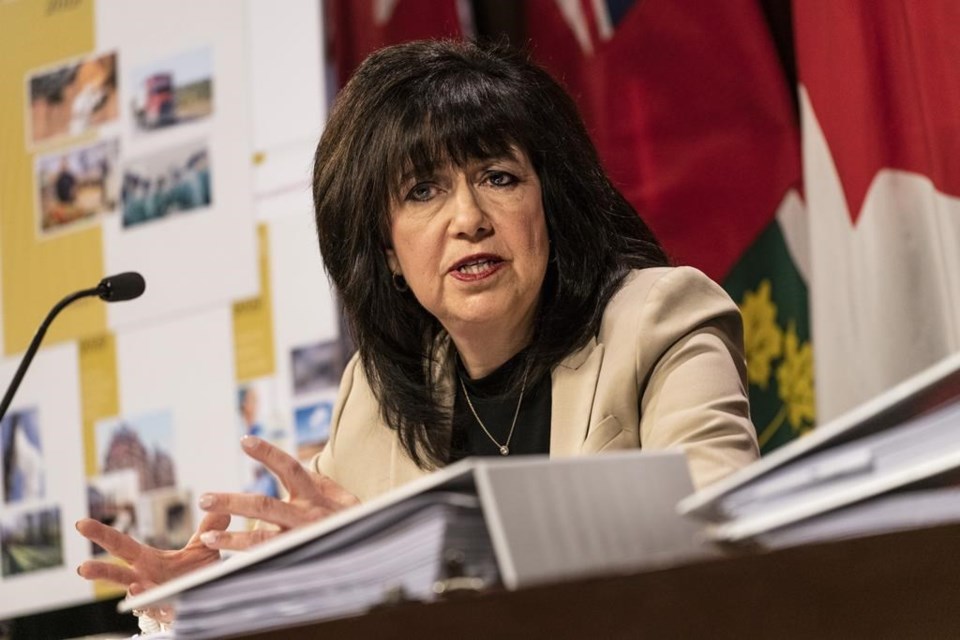TORONTO — Ontario auditor general Bonnie Lysyk released her annual report Wednesday. Here are some of the highlights from her findings:
- About $3.5 billion of the $7 billion spent on COVID-19-related contracts were non-competitive procurements between March 2020 and March 2022
- The Ministry of Health and Ministry of Public Business Service Delivery had $66 million of personal protective equipment that was expired, damaged or became obsolete by March 31, 2022
- Due to a large purchase commitment, the province expects to have more than 100 million N95 respirators by March 2030, worth $81 million
- The province did not consistently apply its prioritization process when it selected 114 hot spot communities to receive COVID-19 vaccines ahead of lower risk communities, which resulted in nine high-risk neighbourhoods excluded in favour of eight low-risk ones
- The lack of a centralized COVID-19 vaccine booking system meant there were about 227,000 no-shows for appointments in 2021 as some Ontarians registered for multiple openings using different booking systems
- COVID-19 vaccination pay was very different for doctors, who earned $170 to $220 per hour compared to nurses at $32 to $49 per hour and pharmacists at $30 to $57 per hour
- The province built a COVID-19 specific database called COVaxON for $144 million despite having an existing vaccination registry system called Panaroma, which was supposed to be expanded from its use for school-aged children to all Ontarians in 2014, but that was never completed even though $170 million was spend on that program
- 77 per cent of the majority of municipalities the auditor general surveyed are unable to accurately  map urban flood risk areas, in part due to lack of provincial elevation data
- Green spaces such as wetlands, woodlands and meadows are important for flood reduction, but over the past 20 years, the percentage of urban land area classified as green has declined by 94 per cent in the province's large and medium urban centres
- There is no longer environmental monitoring of the Niagara Escarpment because there is no staff on the Niagara Escarpment Commission who do that work
- Ontarians pay the highest car insurance premiums in the country, with the average premium having increased nearly 14 per cent from 2017 to 2021 to $1,642
- The auditor general obtained 10 car insurance quotes with where the person lived being the only factor changed and found rates for the same car ranged from $1,200 in London, Ont., to $3,350 per year in Brampton, Ont.
- The Ministry of Transportation prioritized the building of four highway expansion projects that its own experts would not have recommended, including Highway 413 and the Bradford Bypass
- The Ministry of Transportation's business cases for discontinuing tolls and licence plate sticker fees did not follow its own guidelinesÂ
- The Liquor Control Board of Ontario relied heavily on information technology consultants, which made up one third of its workforce and were paid $155 per hour compared to permanent staff who earned $68 per hour
- The province does not track 33 invasive species that are in Ontario and considered high risk by neighbouring jurisdictions
- The province is sometimes years late in regulating invasive species after they are identified as a problem
- The province spends only $4 million annually to fight invasive species despite the $3.6 billion economic impact they create
- As of April 2022, 3,942 of the 5,746 abandoned mines in Ontario had unaddressed hazards and only 111 had been partially rehabilitated
- From 2017 to 2021, the Ministry of Natural Resources and Forestry took more than four hours to dispatch crews to 15 per cent of the province's 3,873 forest fires, with the four longest all in the north
- The province does not track or maintain a centralized repository of floodplain maps and, as a result, does not know where all flood prone areas are
- Only 19 per cent of the 27,000 oil and gas wells in Ontario have been inspected since 2005
- One well in southern Ontario has been leaking oil since 2018 and is scheduled to be plugged sometime in 2023
- Casino operators all reduced their revenue projections since 2019, leading to a reduced revenue share with the province by several billion dollars
- The province sent mystery shoppers to several casinos and found they could launder money at two casinos
- Ontario Power Generation was only using upwards of 50 per cent of installed hydroelectric generating capacity
- In 2021, OPG could have generated enough electricity to power 540,000 more homes
This report by The Canadian Press was first published Nov. 30, 2022.
The Canadian Press


